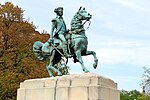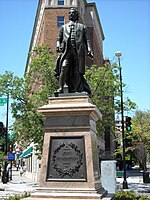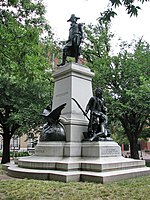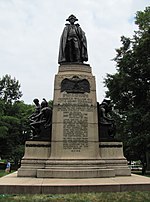Contents
American Revolution Statuary is a group of fourteen statues in Washington, D.C., which honor men whose actions assisted the Thirteen Colonies in their fight against the Kingdom of Great Britain in the American Revolutionary War. They are spread throughout the city, except for the four statues in Lafayette Square, across from the White House, that honor some of the foreign heroes from the war. Some of the statues are located in prominent places, while others are in small parks or stand alone in front of buildings. All of the statues are owned and maintained by the National Park Service, an agency of the United States Department of the Interior. The statuary was collectively listed on the National Register of Historic Places (NRHP) in 1978 and the District of Columbia Inventory of Historic Sites the following year. In addition, most are also contributing properties to historic districts listed on the NRHP.
The first statue in Washington, D.C., honoring Revolutionary War heroes was the equestrian statue of President and General George Washington. It was installed in 1860. The remaining statues were erected from 1878 to 1948. with most being installed in the early 20th-century. All but one of the statues are cast in bronze. Benjamin Franklin's statue was carved in marble. The statues depict American military men, two American politicians, and an eighth statue depicts a military man who was also governor of Massachusetts. Five statues depict European officers who aided the American cause, and a British politician who spoke out for the American cause. The U.S. Congress authorized the original placement of all the statues, and all but four were fully paid for with federal funds. Some of the statues have been moved from their original locations.
History
19th-century
Beginning in the mid-1800s, Congress, societies, and descendants of the American Revolutionary War forces wanted to install statues throughout Washington, D.C., to honor notable men who helped the U.S. win independence from the Kingdom of Great Britain. The first outdoor statue in the nation's capital depicted Thomas Jefferson. It was displayed north of the White House in 1847, but was returned to the United States Capitol in 1874. In 1853, the equestrian statue of President Andrew Jackson was installed in the center of Lafayette Square.[2] It was the first equestrian statue made in the U.S.[3]
Clark Mills was commissioned to create an equestrian statue of George Washington, the country's first president and commander-in-chief of the Continental Army. The equestrian statue was installed in 1860 in Washington Circle, the first of the 14 American Revolutionary statuary to be erected in Washington, D.C.[2] The next statue of a Revolutionary War hero was in honor of Major General Nathanael Greene, erected in 1878 in Stanton Park and designed by Henry Kirke Brown.[4] It is considered one of the city's best equestrian statues.[5][6] The third statue, depicting Benjamin Franklin in a standing pose, was sculpted by Jacques Jouvenal and installed in 1889. It was later moved to its current location in front of the Old Post Office.[7] Franklin's statue is one of four of the statues not paid for by the U.S. government. It was a donation from Stilson Hutchins, founder of The Washington Post.[7] The fourth statue installed, sculpted by Alexandre Falguière and Antonin Mercié, was in honor of Major General Gilbert du Motier, Marquis de Lafayette, one of two French military figures to be honored in Lafayette Square. It was erected in 1891.[8] The park had been named after him during his 1824 visit to the U.S.[5]
20th-century
The majority of the Revolutionary War statues were installed in the 20th-century. The first to be erected in the 20th-century, and the fifth overall, was that of Jean-Baptiste Donatien de Vimeur, comte de Rochambeau, in 1902. The statue of the Comte de Rochambeau was sculpted by Fernand Hamar and is the other French military hero honored in Lafayette Square.[2][9] The sixth statue, sculpted by William Couper, depicts Doctor John Witherspoon, a politician, minister, and signer of the Declaration of Independence. It was dedicated in 1909 and paid for by members of the Church of the Covenant (now known as National Presbyterian Church). It is located at the intersection of 18th Street, Connecticut Avenue, and N Street NW.[10] The seventh and eighth statues, depicting Polish heroes Tadeusz Kościuszko and Casimir Pulaski, respectively, were dedicated on the same day in 1910. Kościuszko's statue, sculpted by Antoni Popiel, was the third installed in Lafayette Square and Pulaski's equestrian statue, sculpted by Kazimierz Chodziński, stands on the eastern end of Freedom Plaza after being moved several times in its history.[11][12] Also in 1910, the statue of Friedrich Wilhelm von Steuben, sculpted by Albert Jaegers, was installed in Lafayette Square.[13]
The John Paul Jones Memorial, honoring the Continental Navy captain, was sculpted by Charles Henry Niehaus and is located in West Potomac Park. It was erected in 1912 and became the tenth Revolutionary War statue to be installed.[2][14] In 1914, another naval hero, Commodore John Barry, was memorialized with a statue in Franklin Square. His statue was sculpted by John J. Boyle.[2] In 1922, the Sulgrave Institution represented by Charles Wakefield, 1st Viscount Wakefield, paid for a statue of Edmund Burke to be erected in a small park at the intersection of 11th Street, L Street, and Massachusetts Avenue NW.[2] The statue honoring a British politician who defended the Thirteen Colonies was sculpted by James Havard Thomas and became the 12th Revolutionary War statue erected in Washington, D.C.[2] The last two installed were the statue of Artemas Ward at Ward Circle, which was sculpted by Leonard Crunelle and dedicated in 1938, and the statue of Nathan Hale, a gift from Yale University President Charles Seymour, which was sculpted by Bela Pratt and dedicated in 1948.[2][15][16]
Washington, D.C., has the largest amount of outdoor statues in the country.[2] Two well-known landmarks in the city, the Washington Monument and Jefferson Memorial, are technically American Revolutionary monuments, but due to their size and grandeur, they are excluded from the list. All of the American Revolutionary statuary are owned and maintained by the National Park Service (NPS), an agency of the United States Department of the Interior.[2] In accordance with Executive Order 11593, by President Richard Nixon, the NPS surveyed and registered statuary of people of the American Revolutionary War in Washington, D.C., to aid in their preservation.[17][18][19] The statues were collectively listed on the National Register of Historic Places (NRHP) on July 14, 1978. The statuary was added to the District of Columbia Inventory of Historic Sites the following year on March 3, 1979. Due to their locations in places originally planned by Pierre Charles L'Enfant, many of the statues are contributing properties (CP) to the L'Enfant Plan. Others are CPs to historic districts, including the four at Lafayette Square, that are CPs to the Lafayette Square Historic District, a National Historic Landmark.[20]
List of statues
See also
- Civil War Monuments in Washington, D.C.
- National Register of Historic Places listings in Washington, D.C.
- Outdoor sculpture in Washington, D.C.
References
- ^ "National Register Information System". National Register of Historic Places. National Park Service. July 9, 2010.
- ^ a b c d e f g h i j k l m n o Scott, Gary (October 3, 1977). "National Register of Historic Places Nomination Form - American Revolution Statuary". National Park Service. Archived from the original on September 29, 2022. Retrieved January 16, 2024.
- ^ "Andrew Jackson, (sculpture)". Smithsonian Institution Research Information System. Archived from the original on April 22, 2023. Retrieved January 16, 2024.
- ^ "Major General Nathanael Greene, (sculpture)". Smithsonian Institution Research Information System. Archived from the original on October 20, 2020. Retrieved January 16, 2024.
- ^ a b Goode, James M. (1974). The outdoor sculpture of Washington, D.C. Smithsonian Institution Press. pp. 84, 371–373.
- ^ Bednar, Michael (2006). L'Enfant's Legacy: Public Open Spaces in Washington, D.C. Johns Hopkins University Press. pp. 201–202. ISBN 9780801883187.
- ^ a b "Benjamin Franklin, (sculpture)". Smithsonian Institution Research Information System. Archived from the original on December 26, 2023. Retrieved January 16, 2024.
- ^ "General Marquis de Lafayette Statue, Lafayette Park, Washington, D.C." National Park Service. 2003. pp. 1–11. Archived from the original on January 15, 2024. Retrieved January 16, 2024.
- ^ "Rochambeau Statue History". National Park Service. Archived from the original on January 9, 2024. Retrieved January 16, 2024.
- ^ "Department of History of the United Presbyterian Church in the U.S.A." Presbyterian Historical Society. 1999. p. 201. Archived from the original on December 29, 2023. Retrieved January 16, 2024.
- ^ "Casimir Pulaski Memorial". National Park Service. Archived from the original on March 20, 2023. Retrieved January 16, 2024.
- ^ Perkowski, Waclaw (May 9, 1910). "May 11 Polish Day in Washington". The New York Times. ProQuest 97093565. Retrieved January 16, 2024.
- ^ "Major General Friedrich Wilhelm von Steuben, (sculpture)". Smithsonian Institution Research Information System. Archived from the original on January 12, 2024. Retrieved January 16, 2024.
- ^ "Commodore John Paul Jones, (sculpture)". Smithsonian Institution Research Information System. Archived from the original on October 3, 2023. Retrieved January 16, 2024.
- ^ "Captain Nathan Hale, (sculpture)". Smithsonian Institution Research Information System. Archived from the original on July 5, 2022. Retrieved January 16, 2024.
- ^ "General Artemas Ward, (sculpture)". Smithsonian Institution Research Information System. Archived from the original on January 7, 2024. Retrieved January 16, 2024.
- ^ "America's National Park System: The Critical Documents - Edited by Lary M. Dilsaver". Archived from the original on July 3, 2007.
- ^ "VI. Executive Orders". Advisory Council on Historic Preservation. Archived from the original on September 27, 2011. Retrieved August 12, 2011.
- ^ "Executive Order 11593--Protection and enhancement of the cultural environment". U.S. National Archives. Archived from the original on 2011-10-26. Retrieved 2017-08-25.
- ^ a b c d e f "District of Columbia Inventory of Historic Sites" (PDF). District of Columbia Office of Planning – Historic Preservation Office. September 30, 2009. Archived (PDF) from the original on July 31, 2017. Retrieved January 16, 2024.
External links
 Media related to American Revolution Statuary at Wikimedia Commons
Media related to American Revolution Statuary at Wikimedia Commons















